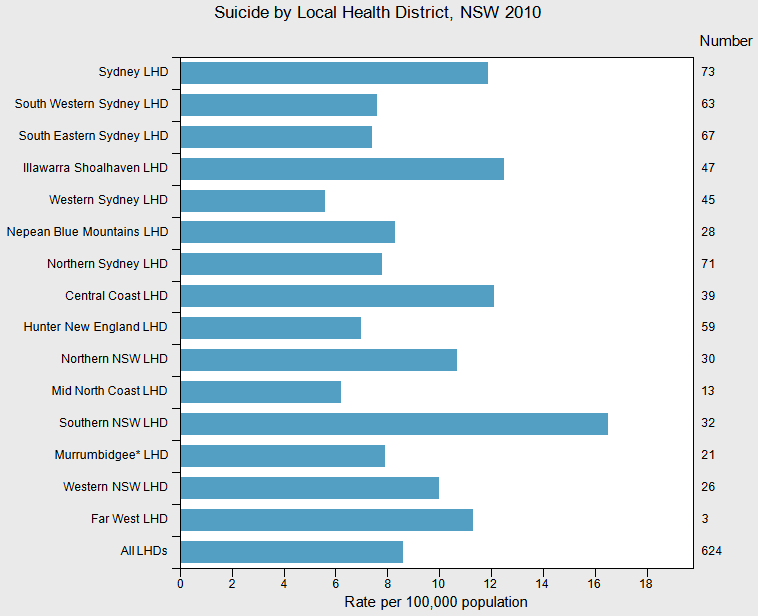In the May 2014 budget papers Australian Prime Minister Tony Abbott, along with Treasurer Joe Hockey and Finance Minster Mathias Cormann, wielded an ideological razor on health funding provided by the Commonwealth .
It has taken the Abbott Government ten long months to realise that the mental health sector, a traditionally underfunded area, could only respond to mooted federal funding cuts by reducing services or closing agencies.
The Minister for Health Sussan Ley finally announced a funding extension for a further twelve months on 2 April 2015 - two days after an Australian Bureau of Statistics media release which confirmed that suicide was still the leading cause of premature death in Australia.
It's almost as though someone in the Prime Minister's office finally put two and two together and realised that there was a public relations disaster of monumental proportions in the offing.
BRIEF BACKGROUND
Excerpt
from an Australian Bureau of Statistics media release on 24 July 2010: New
South Wales was found to have the lowest suicide rate at 8.6 deaths per 100,000
people for the period 2006-2010.
The suicide rate for Northern NSW in 2010 was 10.7 deaths per 100,000 people and for the Mid-North Coast the rate was 6.2 per 100,000 people.
By 2013 New South Wales had a suicide rate of 9.1 per 100,000 people for 2009-2013.
In
2012-13 hospitalisation of young people aged between 15 and 24 years for
intentional self-harm was significantly higher than the state average in
Ballina, Byron, Clarence Valley and Coffs Harbour local government areas and, on
par with the state average in Kyogle, Lismore, Tweed and Richmond Valley
local government areas.
There were 2,522 deaths in Australia from intentional self-harm in 2013.

(a) All causes of death data from 2006 are subject to a revisions process - once data for a reference year are 'final', they are no longer revised. Affected data in this table are: 2009-2011 (final), 2012 (revised), 2013 (preliminary). See Explanatory Notes 52-54 and Technical Note, Causes of Death Revisions, 2011 and 2012.
(b) Includes ICD-10 codes X60-X84 and Y87.0. Care needs to be taken in interpreting figures relating to suicide. See Explanatory Notes 87-93.
(c) Age-specific rates of deaths are the number of deaths per 100,000 population. See Glossary and Data used in calculating death rates (Technical Note) for further information.
(d) The age-specific rates published in this table are calculated for the 2009-2013 reference period. As such, they may differ from age-specific rates published elsewhere in Causes of Death, which are calculated for a single year.
(e) Includes deaths of persons whose age was not stated.
|
| | | | | | |

(a) All causes of death data from 2006 are subject to a revisions process - once data for a reference year are 'final', they are no longer revised. Affected data in this table are: 2009-2011 (final), 2012 (revised), 2013 (preliminary). See Explanatory Notes 52-54 and Technical Notes, Causes of Death Revisions, 2011 and 2012.
(b) Cells with small values have been randomly assigned to protect the confidentiality of individuals. As a result, some totals will not equal the sum of their components. Cells with a zero value have not been affected by confidentialisation.
(c) Includes ICD-10 codes X60-X84 and Y87.0. Care needs to be taken in interpreting figures relating to suicide. See Explanatory Notes 87-93.
(d) Includes 'other territories'.
(e) Includes deaths of persons whose age was not stated.
|
np not available for publication but included in totals where applicable, unless otherwise indicated.
|
The Sydney Morning Herald 8 December 2014:
Mental health organisations are cutting services and shedding staff because of uncertainty about their funding, according to the sector's peak body.
Forty per cent of mental health agencies say they have already lost staff as a result of the uncertainty, while more than half report a reduction in services to their clients, according to a survey of 75 organisations which receive Commonwealth funding, conducted by Mental Health Australia.
Almost half of those surveyed reported difficulty in attracting new staff, and 81 per cent reported a decline in staff morale.
Fifty six per cent of organisations said they had not had communications with the government regarding the future of their Commonwealth funding after June next year, and 85 per cent reported a loss of trust in government among management and staff.
Mental Health Australia chief executive Frank Quinlan said the typically short-term funding cycles for mental health programs, a lack of clarity about how the National Disability Insurance Scheme would affect funding arrangements, and a national review of existing mental health programs had combined to create a "perfect storm of indecision."
"Nobody argues about the need for these programs but at the moment we just can't seem to find anybody to own the future of that problem," Mr Quinlan said.
Health Minister Peter Dutton is considering the review of existing services, conducted by the National Mental Health Commission, after receiving the report late last month….
Excerpt from Australian Bureau of Statistics (ABS) media release, 31 March 2015:
Suicide was once again the leading cause of death for Australian's aged 15 to 44. Suicide accounted for 2,520 deaths in 2013 at a standardised death rate of 10.7 per 100,000 people. The median age at death for suicides is lower than for many other causes at 44.5 years of age. As a result, suicide accounted for over 85,000 years of life lost making it the leading cause of premature death in Australia. [my red bolding]
In a move worth $300 million, mental health services will have their funding renewed for a further 12 months.
Hundreds of contracts were due to end on June 30.
Ms Ley said the 12-month extension would allow services to continue to be delivered while work continued on the current Mental Health Review.










No comments:
Post a Comment